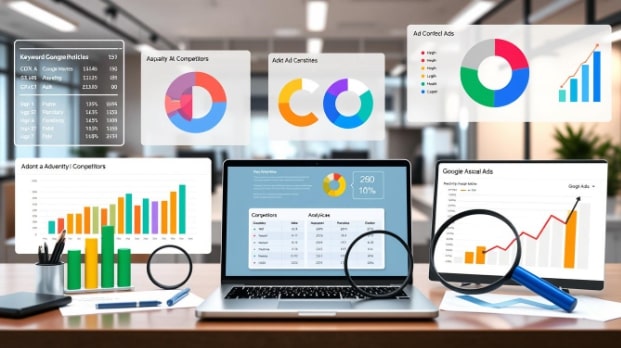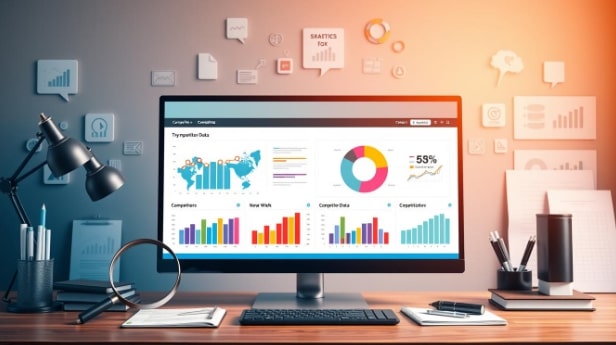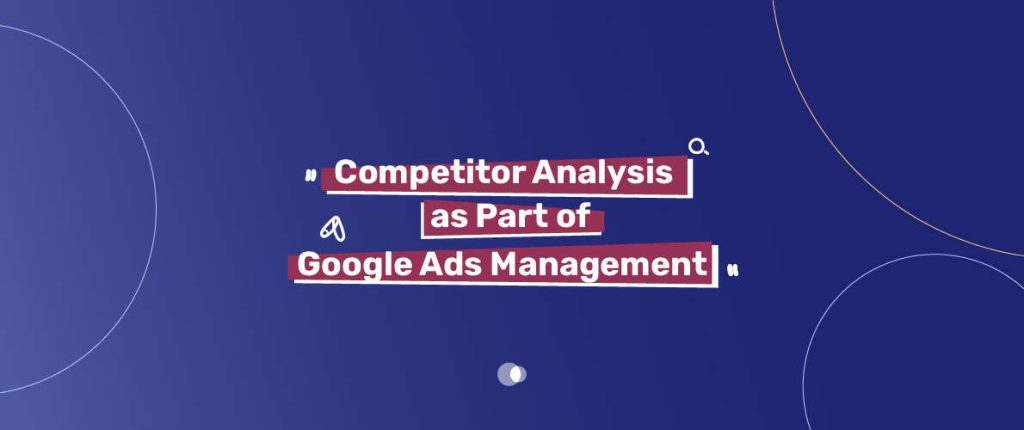In the fast-paced world of digital marketing, it’s key to stay ahead. A crucial part of managing Google Ads is analyzing your competitors. By learning from them, you can improve your campaigns and get better results.
Table of Contents
Google Ads competitor analysis is more than just knowing who your rivals are. It’s about diving deep into their strategies, ad messages, and how well they do. This lets you compare your efforts and make smart choices to outdo them.

Key Takeaways
- Competitor analysis is a vital aspect of successful Google Ads management.
- Understanding the strategies and tactics of your competitors can lead to improved campaign performance and ROI.
- Competitive intelligence helps shape effective digital marketing strategies.
- Analyzing competitor bidding, ad copy, and landing pages can provide valuable insights.
- Leveraging competitive data can optimize budget allocation and improve overall campaign effectiveness.
Understanding the Role of Competitor Analysis in PPC Success
In the world of digital marketing, knowing your competitors is key to success. Competitor analysis gives you insights that help you stand out in Google Ads. It drives your PPC success.
Key Benefits of Competitive Research
Doing deep research on your competitors brings many benefits. It can greatly improve your PPC campaigns:
- Find out the latest trends and best practices to stay ahead
- Discover unique ways to make your product stand out and grab more market share
- Learn more about what your target audience wants and likes
- Improve your ad copy, targeting, and bidding to get better results
Impact on Campaign Performance
Using what you learn from competitor analysis helps you make better choices. These choices can really impact your campaign performance. For example:
- Make your ads more personal and appealing to your audience
- Change your bidding to beat your competitors and get better spots
- Make your ad creatives and landing pages more engaging and effective
Strategic Advantages in the Digital Space
Adding competitor analysis to your digital marketing insights gives you a big edge. It helps your brand shine in the tough online world. By knowing your rivals’ moves, you can craft a stronger PPC plan that puts you ahead.
Essential Tools for Google Ads Competitor Research
Doing a good job of researching your competitors is key to making your Google Ads better. There are many tools and software out there to help you. They can show you how your rivals are bidding, what they’re saying in their ads, and how well they’re doing.
The Google Ads Auction Insights tool is a free choice. It lets you see how your competitors are doing in terms of impressions, position, and overlap. This can help you find where you’re falling short and change your plans.
- Google Ads Auction Insights
- SpyFu, a PPC competitor tracking software that gives you the lowdown on your rivals’ ads, keywords, and budgets
- SEMrush, a top-notch Google Ads competitive analysis tools with keyword research, ad monitoring, and competitor benchmarking
If you want to dig deeper, tools like Adbeat and Adstage are worth it. They dive into your rivals’ ad plans, including ad copy, landing pages, and past data. These AdWords spy tools can give you the edge you need to beat the competition and boost your Google Ads.
“Competitor analysis is not just about understanding your rivals; it’s about understanding yourself, your market, and the strategic moves you can make to gain an advantage.” – Unknown
Using the right mix of these Google Ads competitive analysis tools can help you really get to know your competitors. This way, you can make smarter choices to enhance your PPC strategy.
Google Ads Management Competitor Analysis: Core Components
Doing a deep dive into competitor analysis is key for top-notch Google Ads management. Knowing what your rivals do can help you boost your PPC campaigns. This way, you can beat them in the online world.
Identifying Direct and Indirect Competitors
Finding out who your direct and indirect competitors are is the first step. Direct competitors offer similar stuff and aim at the same people as you. Indirect competitors might not be exact matches but still grab the same customer interest and ad space.
Tools like Google’s Keyword Planner and SEMrush are great for spotting competitors. They let you see their market spots, ad budgets, and keyword plans.
Analyzing Competitor Bidding Strategies
It’s important to get what your competitors are doing with their PPC bidding strategies. Look at their bid tweaks, budget splits, and keyword prices. This can show you where to improve and where they might be weak.
Watching your competitors’ bidding habits helps you tweak your own. This way, you can stay ahead and get the most from your ad spend.
Evaluating Ad Copy and Messaging
Looking at your competitors’ ad copy and messaging can teach you a lot. See how they talk and what they promise. This can help you stand out and connect better with your audience.
Keep checking and comparing your ads to theirs. This helps you make your ads even better over time.
By focusing on these key parts of competitor analysis, you can get ahead in Google Ads. This leads to better campaigns and results for your business.
Benchmarking Your Google Ads Performance Against Competitors
In the world of PPC performance benchmarking, comparing your Google Ads metrics to those of your competitors is key. It gives you valuable insights. By looking at the Google Ads metrics comparison, you can find strategic advantages and areas for improvement in your competitive performance analysis.
To start, you need to gather accurate data on your competitors’ ad performance. Tools like Google Ads, SEMrush, or Ahrefs can help. They provide insights into important metrics like click-through rate (CTR), cost-per-click (CPC), and conversion rate.
- Identify your direct and indirect competitors in the Google Ads space.
- Analyze their bidding strategies, ad copy, and overall campaign performance.
- Compare your own metrics to theirs, highlighting areas where you excel or fall short.
| Metric | Your Performance | Competitor A | Competitor B |
| CTR | 5.2% | 7.1% | 6.4% |
| CPC | $2.15 | $2.87 | $3.12 |
| Conversion Rate | 3.8% | 4.6% | 4.1% |
By comparing your Google Ads performance to your competitors, you can make better decisions. This data-driven approach helps you refine your strategies and budget. It also helps you gain a competitive edge in the digital marketplace.
“Benchmarking your Google Ads performance against competitors is a crucial step in driving sustainable growth and maximizing the return on your PPC investment.”
Analyzing Competitor Keywords and Bidding Patterns
It’s key to study your competitors’ keywords and bidding strategies for Google Ads success. By diving into their keyword research and bid strategy analysis, you can find ways to outdo them online.
Identifying High-Performance Keywords
First, find out which keywords your competitors use best. Look at their ad content, landing pages, and keyword choices. This PPC keyword gaps check can show you new keywords to use, boosting your campaign’s success.
Understanding Bid Adjustment Strategies
Watch how your competitors adjust their bids. See how they react to market shifts, audience changes, and seasonal trends. By studying their bid strategy analysis, you can tweak your bids for better ad timing and audience reach.
Competitive Keyword Gap Analysis
Do a detailed PPC keyword gaps study to find where you’re falling short. Look for keywords your competitors use but you don’t. This can reveal new keywords to target and areas to improve your keyword research and bidding.
“To stay ahead in Google Ads, you need to know your competitors’ keyword research, bid strategy analysis, and PPC keyword gaps. This insight can open up new growth paths and help you optimize better.”
Monitoring Competitor Ad Copies and Landing Pages
In the world of digital ads, checking out your competitors’ ad copy and landing pages is crucial. It’s a key part of Google Ads management. By watching what they do, you can learn a lot to improve your own ad copy analysis and landing page optimization.
Looking at what your competitors do can show you what works. Studying their ad copy can reveal the type of language, tone, and unique selling points that resonate with your shared target audience. This info can help you make your ads more appealing.
Also, checking out your competitors’ landing pages can teach you about landing page optimization. Look at the layout, content, and elements that push users to act. Using these tips can help you make landing pages that stand out.
“Continuous monitoring and analysis of competitor ad copies and landing pages is essential for staying ahead in the digital marketing landscape.”
By keeping an eye on your competitors, you can understand the market better. You can find ways to stand out and make smart choices for your Google Ads campaigns.

Success in Google Ads management comes from being alert and flexible. Use what you learn from competitors to keep improving your campaigns. This will help your business grow and stay ahead.
Leveraging Competitive Intelligence for Budget Optimization
In the world of Google Ads management, knowing your competitors’ strategies is key. It’s not just for better campaign performance but also for optimizing your PPC budget. By studying the competitive landscape, you can uncover insights that guide your advertising budget decisions.
Budget Allocation Strategies
Using competitive intelligence helps in creating smart budget allocation plans. By spotting your competitors’ spending habits, you can tweak your budget to match industry norms. This might mean moving funds from campaigns that don’t perform well to those with better PPC budget optimization and ROI analysis.
ROI Comparison Metrics
Comparing your campaign’s ROI with your competitors’ offers valuable insights. Look at metrics like cost-per-click, conversion rates, and customer lifetime value to see how efficient your ad spend is. This data helps you tweak your budget to focus on the most profitable campaigns and adjust your seasonal advertising trends as needed.
Seasonal Spending Patterns
Watching your competitors’ seasonal spending can guide your budget optimization. Spot the busy and slow seasons in your industry and adjust your budget. You might boost ad spend in peak seasons to grab more demand or cut it in slow seasons to keep profits up.
By tapping into competitive intelligence, you can make informed Google Ads budget decisions. This ensures your ad investments are in line with market trends and your business goals.
Implementing Competitor Insights into Campaign Strategy
To stay ahead online, it’s key to use what you learn from competitors in your Google Ads plans. This helps improve your PPC strategy development, boosts your competitive advantage implementation, and makes your Google Ads campaign optimization better.
Start by finding out which keywords and bidding tactics your competitors use well. By using these keywords yourself, you can get more people to see your ads. Also, looking at your competitors’ ad messages can help you come up with new ideas that speak to your audience.
- Use what you learn from competitors to make smarter choices about keywords and bids.
- Take inspiration from your competitors’ ad copy and messages.
- Change how you spend your budget based on what your competitors do and how well it works.
Using competitor insights should be a constant effort. Keep an eye on what your rivals do, try new things, and adjust based on data. This way, your Google Ads campaigns will stay sharp, relevant, and competitive.
| Metric | Your Campaign | Competitor A | Competitor B |
| Click-Through Rate | 5.2% | 6.1% | 4.8% |
| Cost per Click | $2.45 | $3.12 | $2.78 |
| Conversion Rate | 2.8% | 3.4% | 2.6% |
| Return on Ad Spend | $4.20 | $5.80 | $3.95 |

“By thoroughly understanding and reacting to your competitors’ moves, you can gain a significant competitive advantage implementation in the digital marketplace.”
Conclusion
In today’s fast-changing digital world, using Google ads management services best practices and doing a strategic PPC competitive analysis is crucial. This helps marketers get valuable insights that improve their campaign strategies. These insights lead to better performance and a higher return on investment.
By looking at what competitors do well, like their keywords and ad copies, marketers can learn a lot. This knowledge helps them optimize their budgets, improve their messages, and keep up with trends. This way, businesses can see great results from their Google Ads efforts.
SEM agency The path to success in digital advertising is clear. It involves using Google Ads management best practices and understanding the benefits of PPC competitive analysis. By doing this, marketers can grow their brands, increase visibility, and make their campaigns profitable in the long run.
FAQ
1)What is the importance of competitor analysis in Google Ads management?
Studying your competitors in Google Ads can boost your campaign’s success and ROI. It helps you create better digital marketing plans. This way, you can get ahead in the PPC world.
2)What are the key benefits of conducting competitive research for PPC success?
Competitive research offers many benefits. It helps you understand the market, find ways to stand out, and set smart bids. It also guides you to make your ads better than your rivals.
3)What are some essential tools for Google Ads competitor research?
There are many tools, free and paid, for Google Ads research. You can use Google Ads Spy tools, PPC tracking software, and digital marketing analytics platforms.
4)How can you identify direct and indirect competitors in Google Ads?
To find direct and indirect competitors, look at SERPs and industry publications. Use tools to find those targeting your keywords or offering similar products.
5)How can you benchmark your Google Ads performance against competitors?
To compare your Google Ads with competitors, look at CTR, conversion rate, CPC, and ROAS. This helps you see where you can improve and get ahead.
6)How can you analyze competitor keywords and bidding patterns?
To analyze competitor keywords and bids, find their top keywords and bid strategies. Use a keyword gap analysis to find new chances.
7)How can you monitor competitor ad copies and landing pages?
Watching your competitors’ ad copies and landing pages can teach you a lot. It shows you their messaging and design choices. Use this info to make your ads and landing pages better.
8)How can you leverage competitive intelligence for budget optimization in Google Ads?
Competitive intelligence helps you plan your budget better. It lets you compare ROI and seasonal spending. This way, you can use your budget more wisely.
9)How can you implement competitor insights into your Google Ads campaign strategy?
To use competitor insights in your Google Ads strategy, apply what you learn. Improve your targeting, bidding, ad copy, and overall campaign. This will give you an edge over your competitors.



